Matthew Houde's Blog, page 16
January 21, 2022
Jaco Beaches: Where to Swim, Surf, and Just Relax
Two Weeks in Costa Rica |
Many people visiting Jaco stay right in town and don’t venture far from the main beach. With tons of restaurants, tour shops, and things to do right there, it’s easy to stay in one place. But if you have a rental car and want to explore some less crowded and more scenic beaches, there are plenty of options. In this post, we’ll describe what Jaco Beach is like. We’ll also give you more ideas for beaches in the Jaco area within a short drive.

Jaco Beach or Playa Jaco is located along Costa Rica’s central Pacific coast. At only about 1.5 hours from San Jose, it is the closest major beach town to the capital city. Because of this, on weekends and holidays, you’ll often find it packed with locals.
The beach is fairly long, at about 2.5 miles (4 km). The main street in town backs the beach. This means that you’re just a short walk to the sand from restaurants and shops.
The waves at Jaco Beach are fairly big, making it a good surfing beach. There are rip tides to be aware of, but you can still wade in the shallow water.

This beach is usually busy and has a fun vibe. The town has a party reputation and there are many bars, but it draws all kinds of people, including families.
The middle section of the beach, close to many businesses, hotels, and condos, is the busiest area.
The southern end near Hotel Club del Mar is usually the quietest spot. There are also some scenic rocks here that form the southern border of the beach.
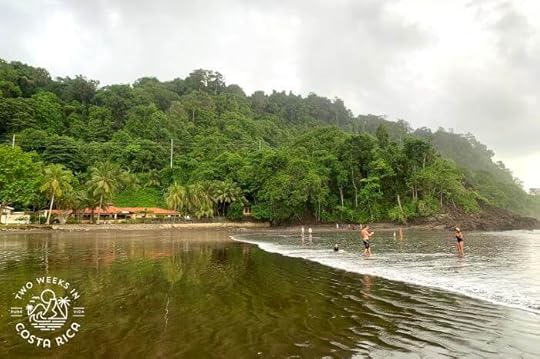 Southern end of Jaco Beach
Southern end of Jaco BeachTip: Most accommodations in Jaco, aside from some condos, are budget options. For tips on where to stay, check out our Jaco destination guide.
You can rent chairs and umbrellas in several different places. Hotels that are right on the beach usually have them for guests.
Jaco isn’t the cleanest beach in Costa Rica because it gets a lot of foot traffic and is close to development, but it’s still a nice place to spend the day.
Other Beaches in the Jaco AreaPlaya Mantas and Playa BlancaArguably the most beautiful beaches in the Jaco area are Playa Mantas and the adjacent, Playa Blanca.
These beaches are about a 20-minute drive north of Jaco. They are best accessed with a rental car.
Tip: For a 10% discount on a rental car and other free extras, check out our Rental Car Discount. You can search prices and availability using the link on our website.
Playa Mantas is a gorgeous cove with turquoise water and a thick backing of palm trees and jungle. It has calm water almost all the time, making it a great spot for swimming, kayaking, and stand-up paddleboard. This is a lovely beach for families with young children.
 Main area of Playa Mantas
Main area of Playa MantasIf you’re up for some adventure, plan your visit at low tide and check out Playa Blanca next door. To access this white-sand beach, you have to climb over a small hill since direct beach access is restricted to guests at Hotel Punta Leona.
It’s worth the trek, though. Playa Blanca is unique because of its fluffy white sand. This side of the point gets more wind, making the water a little more choppy, but still swimmable in some spots. There are also gorgeous rock formations at both ends of the beach.
[image error]Northern end of Playa Blanca near the access point from Playa MantasThese beaches are super popular. For more information on visiting, including the best times to go to avoid the crowds, check out our separate posts:
Playa Mantas: Calm Water and a Local Vibe
Playa Blanca: A White-Sand Oasis Near Jaco
Playa HermosaFive minutes south of Jaco is one of Costa Rica’s most popular surfing beaches.
Playa Hermosa is a long, dark sand beach with strong, consistent waves. It’s not a place to come for swimming, but the beach itself is quiet and peaceful compared to Playa Jaco.
There’s a small area of town with a little going on towards the northern end. Here, you’ll find a few beachside restaurants and hotels. These have a fun, casual vibe.
Going south, the beach is part of a conservation area so there’s no development on the oceanside, just scattered palm and almond trees. There are, however, some condos and houses just across the beach road.
This beach does not have much shade.
[image error]Playa Hermosa near JacoStill part of Playa Hermosa, but on the opposite side of the highway, are more options for accommodations inland. Here, you’ll find many Airbnbs and vacation rentals.
Playa Esterillos OesteAbout 25 minutes south of Jaco is the small town of Esterillos Oeste. This is a locals’ town, but it also has a sizeable population of expats.
Playa Esterillos Oeste is a surfing beach, but it also has incredible tidepools that form at low and mid tide. At mid tide, you’ll find several deep pools with calm water for swimming. At lower tides when there’s less water, you can explore the sea life in the shallow pools.
Head to the northern end of the beach to experience these tidepools. There’s a separate parking area. Just walk to the right after you park and go around the point.
 Tidepools at Playa Esterillos Oeste
Tidepools at Playa Esterillos OesteIn addition to the tidepools, Playa Esterillos Oeste has a cool mermaid statue that you can visit at low tide by walking on the rocks.
For more information, check out our post, Esterillos Oeste: Surfing, Serenity, and La Sirena.
Playa HerraduraJust north of Jaco, near Los Suenos Marriott, is Playa Herradura.
Playa Herradura is a sheltered cove with calm water. You’ll see lots of boats moored on the northern end, at Los Suenos, the largest marina in the area.
The beach itself is fairly rocky but a decent spot to check out. It does get very busy with locals. The small shady area up by the beach road is often packed on weekends.
A few restaurants serving local food are right across from the beach.
 Playa Herradura, “Horseshoe Beach”Conclusion
Playa Herradura, “Horseshoe Beach”ConclusionIf you’re visiting Jaco, it’s definitely worth checking out some of the other beaches in the area. Even just driving 10 minutes, you’ll get a completely different feel from the busy beach scene on Playa Jaco.
 Sunset at Jaco BeachHave a question about visiting a beach in the Jaco area? Ask us below.Looking for more information to plan your trip? Check out these posts:
Sunset at Jaco BeachHave a question about visiting a beach in the Jaco area? Ask us below.Looking for more information to plan your trip? Check out these posts:Jaco: Costa Rica’s Booming Beach Town – Read our destination guide for more activities in the area.
Jaco Restaurant Guide: Jaco has an amazing selection of restaurants. Read about our favorite spots for beachfront dining and more in this article.
Vacation Rentals in Costa Rica: Safety and What to Look for – Vacation rental homes are a great option in the Jaco area. Get our Costa Rica-specific tips here.
The post Jaco Beaches: Where to Swim, Surf, and Just Relax appeared first on Two Weeks in Costa Rica.
January 11, 2022
Testing Positive for Covid in Costa Rica
Two Weeks in Costa Rica |
With Covid spreading rapidly due to the omicron variant, many people are wondering what happens if you test positive for Covid in Costa Rica. Countries like Canada, the United States, and much of Europe are requiring a negative test before you can board a flight home. But what if the test doesn’t come back negative? In this post, we’ll give you an overview of Costa Rica’s quarantine requirements and some practical considerations as well.

Here are some helpful links before we get into what happens if you test positive.
For Costa Rica’s current Covid numbers, read our post, Costa Rica and the Coronavirus.
For current entry requirements, read our post, Traveling to Costa Rica During Covid-19.
For information on Covid testing requirements for getting back into the United States, read our post on Preflight Testing.
For information on Covid testing locations in Costa Rica, read our post, Where to Get a Covid Test. It has options all around the country, in San Jose and major tourist destinations.
Background – Testing Positive for Covid in Costa RicaThe Costa Rican government does not have clear information for tourists about what happens if you test positive for Covid during your trip. The official Tourism Board (ICT) currently does not cover this on their website.
Below we give our understanding based on various regulations from the Costa Rica Ministry of Health and what we have gleaned from living here and working in the travel industry. You can find the Ministry of Health’s regulations on their website. Here is a link to one important document (in Spanish) for those interested.
You also can find some information on the US Embassy’s website.
Although we have tried to ensure that the information we are giving is accurate, your experience may differ somewhat.
If you have tested positive in Costa Rica and want to share your experience, please leave a comment below to help others know what to expect.
Receiving a Sanitary OrderPrior to being tested for Covid in Costa Rica, the lab or medical clinic will ask for certain personal information like your email and phone number. They will use this to email your test results. Remember too, that you will have provided the Costa Rican government with personal and travel information when you fill out the online health pass before entering the country.
If your test comes back positive, the testing facility will send you the positive test result by email. There is a formal procedure where they will then notify the Costa Rican government.
You are then supposed to receive a quarantine order, called a sanitary order in Costa Rica. This will come from the Ministry of Health or local hospital/clinic. Usually, it takes a day or two to receive it after the positive test result.
 Sample sanitary order from Costa Rica’s Health Ministry
Sample sanitary order from Costa Rica’s Health MinistryQuarantine orders can be for 10-14 days. The exact number varies depending on the severity of symptoms. The Ministry of Health regulations say, for example, that people who are asymptomatic should receive a 10-day sanitary order.
The start date of the sanitary order is usually the date of the positive test but it can be earlier (see FAQs below).
QuarantineTravelers can pick where they do their quarantine. The Costa Rican government does not have quarantine hotels. You can pick any hotel or vacation rental that has space and make your own arrangements.
You will need to inform the government of where you will be doing your quarantine. The Ministry of Health or local public clinic is supposed to call you every day to make sure you’re staying there and not leaving, in compliance with the order.
We have heard, however, that not everyone gets called.
Still, you should know that Costa Rica takes sanitary orders very seriously so you would not want to be caught not abiding by one. It is a legally binding order. The only exception we have seen in the regulations for leaving during a quarantine is for getting medical attention. There is a hefty fine for being caught in violation of a sanitary order. Depending on the violation, the fine is 450,200 to 2,300,000 colones or about $700-$3,560.
You will need to pay all expenses associated with your quarantine. This makes it a very good idea to get travel insurance.
Some companies do cover quarantine expenses. Check out our post, Costa Rica’s Required Travel Insurance: 15 FAQs. Though insurance is now not required for those who are vaccinated, this article has links to several travel insurance companies that cover quarantine.
Airline Quarantine RequirementsTravelers also should check the quarantine requirements of their airline. The US Embassy advises that most US airlines require a person receiving a positive test result to do a 14-day quarantine before boarding a flight. This is according to CDC guidelines.
FAQs About Testing Positive for Covid in Costa RicaWhat about the rest of my travel group/family? If they test negative, can they leave?It seems that as long as the rest of the group tests negative and is not showing symptoms, they can leave Costa Rica. A sanitary order is in the name of a specific person.
This was the case for a family who we helped with some travel planning. Four out of five people tested negative. The person who tested positive was a child so one parent stayed back with them, while the others returned to the United States.
When does the sanitary order begin and expire?Ministry of Health regulations state that the sanitary order begins on the positive test date and cannot be retroactive. However, the regulations then go on to explain that in determining the exact number of quarantine days, they will take into account the time between the onset of symptoms or the last contact with a positive case. We have heard of cases where the sanitary order date began before the positive test date.
The sanitary order will have a specific expiration date. The order expires at the end of that day.
Can I retest out of the quarantine?According to the US Embassy, the Ministry of Health has stated that sanitary orders cannot be appealed. This is so even if the results of subsequent tests taken during the mandatory quarantine are negative. So it seems you need to wait out the expiration of the sanitary order.
What do I have to do to get back home after my quarantine? Retesting and proof of recovery.The requirements to board a flight after testing positive differ by country.
For US travelers, the CDC does not recommend retesting within three months after a positive test result. This is because people who have recovered from Covid may continue to test positive.
The CDC advises that if you have had a positive test within the past 90 days, and you have met the criteria to end isolation, you may travel with your positive test result and a signed letter from a licensed healthcare provider or public health official that states you have been cleared for travel. These are referred to as documentation of recovery.
The CDC site explains that the letter must have information that identifies you personally (e.g., name and date of birth) that matches your passport. The letter needs to be signed and dated on official letterhead with the name, address, and phone number of the healthcare provider or public health official.
Where should I quarantine?Being quarantined isn’t all that fun, of course, but you can make the best of it. We’ve heard of people picking Airbnbs with a private pool and other things to do on the property so that they can pass the time faster.
We also have had clients end their stay at a beach location (and get tested locally there). That way, if they test positive, they will have a nice spot to wait out their quarantine.
 How would this be for a view during quarantine?How can I get supplies when I’m in quarantine?
How would this be for a view during quarantine?How can I get supplies when I’m in quarantine?In popular tourist destinations in Costa Rica, it is actually easy to get food delivered to your door. Most restaurants offer express (delivery) for free or a small charge. A few grocery stores deliver too, especially smaller ones. Often the driver will have a credit card reader that you can just tap your card to pay.
It’s worth asking your Airbnb host or hotel front desk if they could help get you groceries. They should be able to do some shopping for you and just charge for their time. Costa Ricans are usually very friendly and helpful.
ConclusionFirst, we hope that your Covid test comes back negative! We also hope that our article has given you a better idea in general of what happens if you test positive for Covid on a trip to Costa Rica.
Have a question about testing positive for Covid in Costa Rica? Ask us below.Looking for more information to plan your trip to Costa Rica? Check out these posts:Itineraries: Still trying to figure out the best itinerary for your trip? Check out our sample itineraries.
Getting a SIM Card for Costa Rica: Read our tips on using local cell carries for phone and Internet in Costa Rica.
Driving in Costa Rica: What to Know Before You Go – Planning to rent a car? Read our guide for information on what to expect for road conditions and customs.
The post Testing Positive for Covid in Costa Rica appeared first on Two Weeks in Costa Rica.
January 7, 2022
Tarcoles River Crocodile Bridge: A Stop to See Crocs
Two Weeks in Costa Rica |
If you are visiting Costa Rica’s central Pacific coast, a fun stop between destinations is the famous Tarcoles River crocodile bridge. This bridge has giant crocodiles sunbathing and swimming below. You can park right off the main highway and walk onto the bridge to see them for yourself. This is a perfect, free activity to help break up a long drive. In this post, we’ll give you all the details to plan a stop.
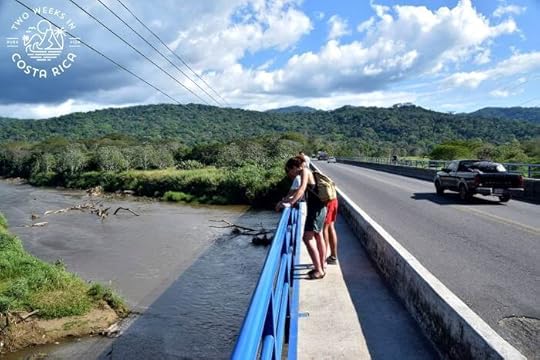
The Tarcoles River crocodile bridge is located on Route 34, a mostly two-lane highway that runs from north to south along Costa Rica’s central and southern Pacific coast.
The bridge is a convenient stop on the way to destinations like Jaco, Manuel Antonio, Dominical, and Uvita.
From the San Jose Airport (SJO), the drive to the bridge is about 1-1.25 hours, depending on traffic. Jaco is about 30 minutes south and Manuel Antonio is about 1.5 hours from the bridge.
As the name implies, the Tarcoles River crocodile bridge crosses the Tarcoles River. This wide river flows all the way from the mountains in Costa Rica’s Central Valley before emptying into the Gulf of Nicoya/Pacific Ocean.
The Tarcoles River is most famous for its crocodiles but sadly is also known as one of the country’s most polluted rivers. This is largely because its headwaters start in Costa Rica’s most populated areas. Regardless, the river is beautiful and teeming with birds and of course many crocodiles.
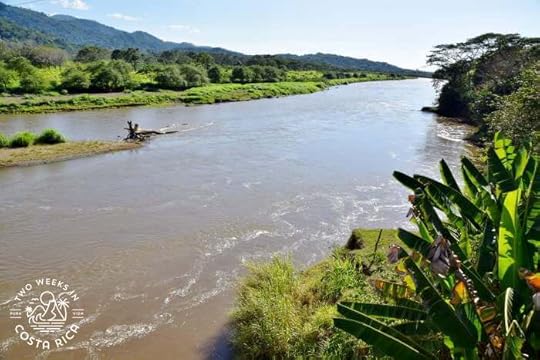
When arriving at the Tarcoles River crocodile bridge (from the north going south), you’ll see a cluster of souvenir shops and small restaurants just before the bridge. This is where you will park.
Often a parking attendant will help you pull in and find a spot. These attendants work for tips. It is customary to give them some change or a small bill when leaving (around 500 colones or about $1).
Tip: Even though the parking attendants are around and can watch your car to some extent, there is a lot of coming and going in the area. If you are traveling with your luggage, we recommend taking turns walking onto the bridge so that someone stays with the car, just to be safe. In the past, car break-ins were very common here. The situation has improved but it could still happen.
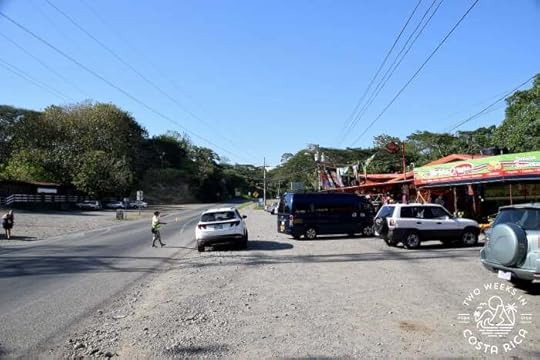 A parking attendant helping someone pull back onto the highwayWalking Onto the Crocodile Bridge
A parking attendant helping someone pull back onto the highwayWalking Onto the Crocodile BridgeBoth sides of the Tarcoles River crocodile bridge have sidewalks and railings now so you can walk out safely without interfering with traffic. Cars and trucks usually slow down over the bridge but use caution as you will still be very close to the busy highway.
It is also important to note that the railings have a lot of space between them where young kids could slip through. Be careful with small children or just skip it altogether.
Each side of the bridge offers a different view of the river. Both are worth checking out. Just be sure to walk back towards the parking area to cross over and don’t try to jump over the concrete barriers. Cars can appear quickly!
During busy tourist months, holidays, and weekends, the bridge can get busy but is usually not too crowded. Since the bridge is long and most people only spend 10-15 minutes looking at the crocodiles, there is usually plenty of space.

The crocodiles found in the Tarcoles River are American crocodiles (Crocodylus acutus). These can reach up to 20 feet (6.1 meters) long and weigh up to 2,000 pounds (907 kg)! Though some giant ones frequent the bridge, many are about 10-15 feet (3-4.5 meters) long.
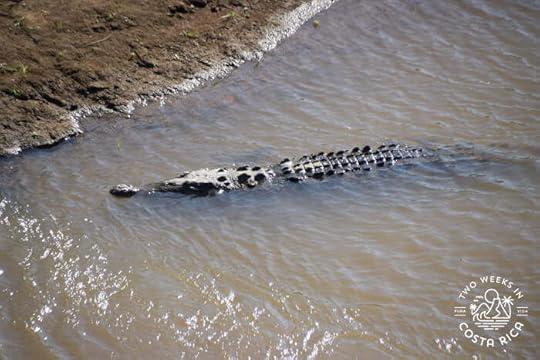
In our experience, most of the crocodiles can be seen from the middle part of the bridge on either side. They are down below in the river, about 30-40 feet (9-12 meters) away.
Which side of the bridge has more crocodiles depends on the time of year and rainfall. During our last visit, the water was higher so most of the crocodiles were perched in the water. On other visits when the water was lower, we have seen more crocs sunbathing in clusters on the riverbanks.

Though it may sound fun, it is important not to toss any food down to the crocodiles. The wrong diet can be bad for them. Equally important, it is forbidden by Costa Rican law to feed them.
The crocodiles have plenty to eat and naturally prey on birds, small-to-medium sized mammals, turtles, crabs, snails, frogs, and anything else they might find in or around the river.
Amenities at the Crocodile BridgeIn addition to the main attraction (the crocodiles), this area has developed into a tourism rest stop in recent years, with some useful amenities. There are a couple of small sodas (local restaurants), a Pops ice-cream shop, coffee shop, a few souvenir stands, a fruit stand, and two small convenience stores.
For those needing a restroom break, the restaurants will allow customers to use the bathrooms. Or if you aren’t eating, there is a separate bathroom behind the plaza on the far left. They charge a small fee (about 500 colones/$1).

If gazing at the crocodiles from up on the bridge isn’t enough and you want a closer view, there is a way. Crocodile tours are available in the nearby town of Tarcoles (10 minutes away).
Crocodile tours bring you along the Tarcoles River on a covered boat. You’ll get very up close and personal with many crocodiles and be able to see the river’s exotic bird species as well. Tours last about 1 hour and 45 minutes.
To learn more about a crocodile tour we recommend out of Tarcoles, read our post, A Riverboat Adventure on the Tarcoles River.
[image error]
ConclusionA stop at the Tarcoles River Crocodile Bridge is a great way to stretch your legs and break up a long drive. This was one of the first stops we ever made when we began to explore Costa Rica many years ago. We hope you’ll add it to your adventure too.
Have a question about visiting the Tarcoles River crocodile bridge? Ask us below. Looking for more information to help you plan? Check out these posts and pages:Rental Car Discount – If you’re planning to rent a car, use this discount to save with one of the country’s best rental agencies. No hidden fees and free extras when booking through our site.
Manuel Antonio Trip Planning – Heading to Manuel Antonio? Check out some of our favorite hotels, restaurants, and activities.
Hanging Bridges in Costa Rica: Where to Go for the Best Experience – Walking through the forest canopy on suspension bridges is an experience you don’t want to miss. Find out the best options near your destinations with this article.
The post Tarcoles River Crocodile Bridge: A Stop to See Crocs appeared first on Two Weeks in Costa Rica.
December 10, 2021
Getting a SIM Card for Travel in Costa Rica
Two Weeks in Costa Rica |
If you’re like most people, your phone is an important extension of your daily life. And while you may be able to turn off work emails during your vacation, you still want to be able to connect to the internet while abroad. After all, you don’t want to miss posting those gorgeous photos or chatting with family and friends while away. In this post, we’ll give you details on how to get a prepaid SIM card for travel in Costa Rica.
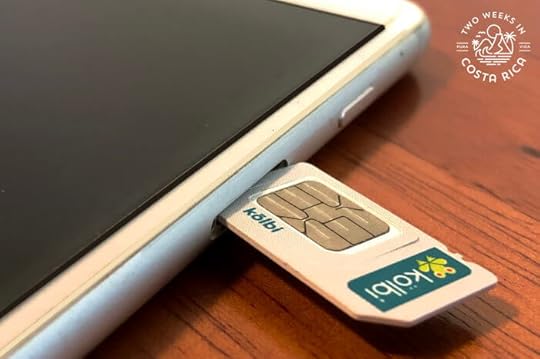
Costa Rica has an extensive network of 3G, 4G, and 4.5G cell phone towers. This allows you to connect to the internet or make a local call in most places around the country.
Of course, with Costa Rica’s rugged terrain, there are still places where the towers don’t reach. They can be partially blocked by mountains or trees. If you are traveling to known tourist destinations, though, you will likely find good coverage.
Major highways and most popular secondary roads usually have good coverage too. However, you’re likely to find some spotty zones along the way.
Important: The mobile networks in Costa Rica will not work if your phone is locked by a cell phone provider in your home country. This is the most common problem people have when trying to insert a foreign SIM card. If you have a contract with a cell phone carrier, contact them first to see if you can get the phone unlocked for international travel. If not, they may be able to offer you a temporary international calling/data plan.

There are several cell phone networks in Costa Rica. The biggest is the government-owned Kolbi. This has the most extensive coverage (see coverage map here) and is also the most popular.
Others that are growing in popularity are Claro and Movistar. These companies have been expanding their coverage but are newer to the market.
Tip: If you will be in Costa Rica for a long-term visit and staying in one place, be sure to ask your host/property manager which company has the best coverage in that area. In some rural areas, for example, Kolbi doesn’t work well, but Claro does. This can be key to getting fast, reliable internet in parts of the country without a cable or fiber option connection.
Prepaid vs. Postpaid SIM CardsWhen getting a new SIM card in Costa Rica, there are two options, prepaid (prepago) and postpaid (postpago).
Prepaid SIM cards are the easiest to get and anyone with a passport can buy one.
Prepaid SIMs are sold for around 1,000 colones (about $1.50) plus a certain amount of money for minutes and data. These are pay-as-you-go plans, so once you use the balance, you won’t be able to make calls or use the internet until you recharge it with more money (details below). You can add as much money as you want to a SIM card. It is very affordable. 5,000 or 10,000 colones (about $8 or $16) will last you a long time.
Postpaid SIM cards that give you a certain amount of data and minutes are billed monthly (the month after you use the services). You need to be a legal resident with a cedula or DIMEX card to get one. When doing so, you will sign a contract with the mobile provider.
Getting a SIM Card in Costa RicaGetting your cell phone set up with a Costa Rica SIM card is easy. Just make sure you are using a phone that is unlocked or allows a dual SIM card. We’ll cover the rest of the process below.
Buying SIM Cards at the AirportPreviously, you could purchase a Kolbi SIM card at either SJO or LIR Airports. However, these desks have since been closed. There is a Claro desk at the baggage claim of SJO Airport, but it isn’t always open.
 Claro at the airport
Claro at the airportIf you need a SIM card right away, there are some options only a 5 to 10-minute drive from each international airport.
If arriving at SJO Airport, you can go to City Mall in Alajuela (map). It’s about 5 minutes away. Kolbi, Claro, and Movistar all have storefronts inside the mall.
If arriving at LIR/Guanacaste Airport, you can go into downtown Liberia. There is a Kolbi store (map), Claro (map), and Movistar (map) right in town. These are about 10-15 minutes from the airport, depending on traffic.
Where Else to Get a SIM Card?Besides the locations near the airports, there are plenty of other places to get a Costa Rica SIM card.
ICE OfficesICE (Instituto Costarricense de Electricidad) is Costa Rica’s government-run electric and telecommunications agency.
They have offices in most larger towns and some rural locations as well. Their buildings are usually white, blue, and yellow. People often go here to pay their electric and phone bills, so sometimes lines are long.
Most ICE offices have staff that will help you set up a new Kolbi SIM card. Kolbi is the mobile provider branch of ICE and is also government run.

In addition to the ICE offices, there are some Kolbi storefront locations around Costa Rica. You can find a searchable list here. You’ll just need to know the province and canton (county) where you are going.
The list will give you both the ICE offices that offer SIMs and Kolbi store locations. Most of the storefronts are in the San Jose area, but there are some random ones around Costa Rica.
Here are a few Kolbi stores worth mentioning, which are near popular tourist destinations:
La Fortuna (Arenal), right in downtown, across from the Red Cross (Cruz Roja)Huacas (on the way to many Guanacaste beaches like Tamarindo and Flamingo)Limon on the Caribbean coast (across from the post office, Correos de Costa Rica)Claro and Movistar Retail StoresSimilar to the Kolbi storefronts, you’ll find retail stores for Claro and Movistar that also sell SIM cards. These are actually more widespread, with locations in many tourist destinations.
You can find the list of Claro stores here and the list of Movistar locations here.
[image error]
Setting Up Your Costa Rica SIM CardWhen you purchase your SIM card, the mobile provider will help set up your phone and test it to make sure it works. They will give you the phone number that corresponds to the SIM so that you can save it.
Each provider is different, but they all have certain packages that include phone minutes, data, and usually some free usage for things like WhatsApp, Waze, and Facebook.
Kolbi, for example, has a tourist package that includes 5GB of internet, 5GB for specific apps (WhatsApp, Instagram, Facebook, and Waze), plus 100 minutes for national calls. The price is 12,000 colones plus 4% VAT. That’s around $20, depending on the exchange rate.
This, along with connecting to Wifi at your accommodations, should be plenty for a short vacation.

If you do run out of data or phone minutes, you can easily add more money to your balance.
Most grocery stores (also called supers or mini-supers) can either add minutes using their computer or sell you a card with a code to add minutes.
With the card, you need to call the toll-free number and enter some numbers from the back and follow instructions. Cell phone stores (repair shops, accessories, etc.) also usually can help add minutes.
When looking to recharge, just ask if they sell Kolbi, Claro, or Movistar, whichever you have a SIM card for. You can also usually see the logos for each provider either at the register or on a sign outside.
After you have successfully recharged, you will receive a text message with your new balance.
Kolbi users can check their balance by calling *888*1*1#
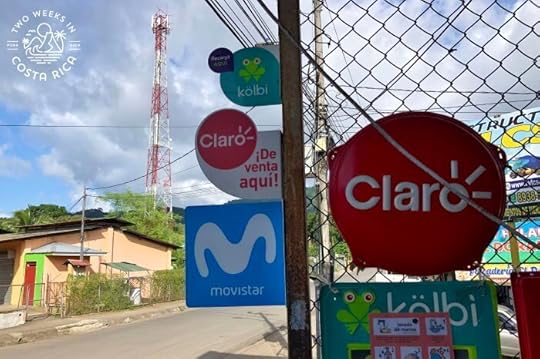
Getting a SIM card in a foreign country may seem intimidating, but we hope this article has helped you navigate the process. Now that you are connected, you can rest easy and enjoy your trip to Costa Rica!
Have a question about getting a SIM card in Costa Rica or want to share a tip? Leave a comment below. Looking for more information to help you plan? Check out these posts:Rental Car Discount – Get a discount on your rental car through Adobe, one of the country’s best companies. Add a Wi-Fi stick too if you think you’ll need even more data for your trip.
Packing for Costa Rica: The Essentials – If you are getting all those final items together, make sure to read this post. It may remind you of something you forgot.
Best Hotels Near SJO Airport – Looking for a comfortable place to stay that doesn’t feel like your typical airport hotel? Check out this handpicked list of our favorites near SJO.
The post Getting a SIM Card for Travel in Costa Rica appeared first on Two Weeks in Costa Rica.
November 26, 2021
Playa Mantas: Calm Water and a Local Vibe
Two Weeks in Costa Rica |
While much of Costa Rica’s central Pacific coast has larger waves for surfing, there are a few beaches with nice calm water. One such place is Playa Mantas. This cove, just north of Jaco, has turquoise water and a thick backing of jungle. Because of its beauty, it is a popular spot. In this post, we’ll explain more about the beach and give some tips on the best times to visit.
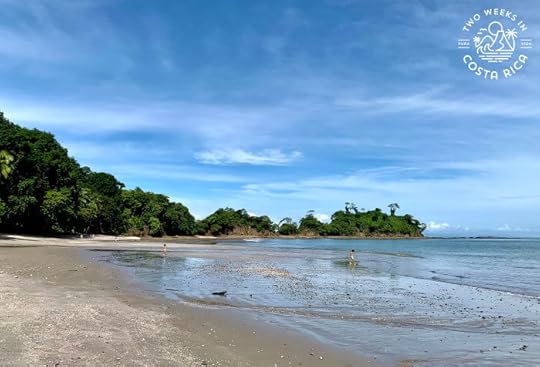
Playa Mantas is located about 15 minutes north of the tourism hotspot, Jaco. It is not far off Highway 34 and can easily be visited on a day trip from Jaco. See directions below.
Playa Mantas is one of the closest scenic beaches to San Jose, at just over one hour. Because of this, it is very popular among locals. Costa Ricans from the capital city and elsewhere flock to this beach on weekends. The parking lot often fills up, so if you’re planning a visit on a Saturday or Sunday, be sure to arrive early.
[image error]Looking down the southern end of Playa MantasPlaya Mantas is one of the beaches that fronts Punta Leona Resort. Punta Leona is a fairly large, more basic all-inclusive resort. It is spread out along the beach, and has different sections with bungalows and condos.
Punta Leona also has direct beach access to the neighboring Playa Blanca (see more below). Since all beaches in Costa Rica are public, you can access Playa Mantas and Playa Blanca even if you’re not staying at the resort.
About Playa MantasPlaya Mantas is a wide cove, flanked by a rocky outcropping on one end and a vegetated point on the other.
The sand is a pretty gray color. The waves are gentle and perfect for swimming, even with young kids. In dry season when there is little rain (December to end of April), the water is a gorgeous turquoise shade.
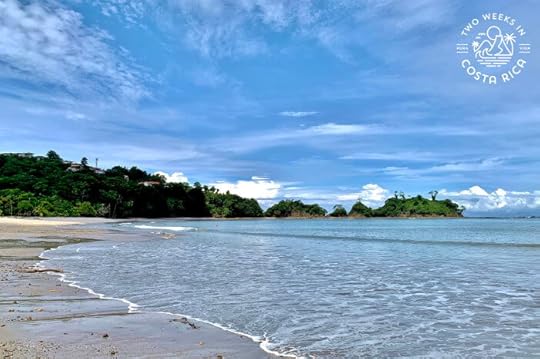 Gentle waves lapping the shore
Gentle waves lapping the shoreThe northern end of the beach is the quietest because it is the farthest from the main path.
This stretch, in our opinion, is one of the nicest parts of the beach. A steep green hillside backs the sand, creating a layer of shade during much of the year. A large outcropping of rocks forms the northern boundary. Here, you can find crabs and other sea creatures, making it a fun spot to explore.
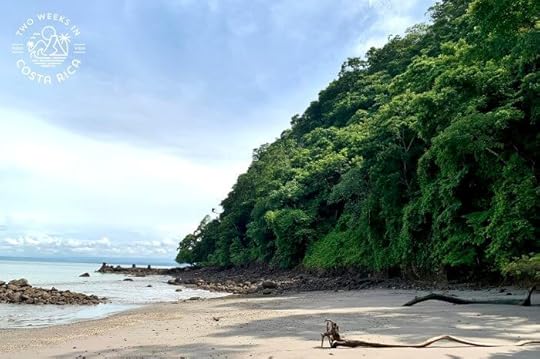 The green hillside and rocks along the northern end of the beach
The green hillside and rocks along the northern end of the beachThere are also the remnants of some pilings here, probably from an old dock. We’ve seen people walk out to this area for pictures.
The middle section of beach is the busiest. This is because it’s right where the walking path from the road ends.
This area has some tall palms and thick shrubs. Large groups set up here for the day, or even the whole weekend. You’ll see barbeques, tables with food and drink, and maybe even tents for camping.
The southern end is also very pretty but usually busy too. This area has more palm trees and several thick, shady almond trees. The very southern end has large rocks that form pools at low and mid tide.
 Rocky outcroppings on the southern endAccess to Playa MantasParking
Rocky outcroppings on the southern endAccess to Playa MantasParkingUnlike most beaches in Costa Rica, Playa Mantas has a designated public parking lot run by the municipality. The lot has a guard and gate.
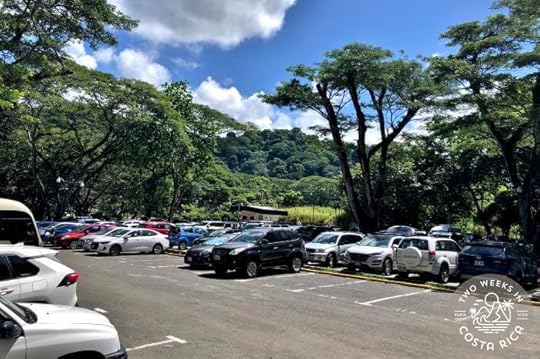 The public parking lot and guardhouse in the background
The public parking lot and guardhouse in the backgroundAlthough it is large, it does fill up on weekends and holidays, as we mentioned above. When it’s full, the attendants will put up a sign to let you know.
Tip: If you can, visit Playa Mantas during the week (Monday-Friday). It is almost always empty on weekdays. Weekends and holidays are the busiest, especially around Christmas, Semana Santa (Easter Week), and other long holiday weekends. If you’re only able to visit on Saturday or Sunday, arrive by 9:00 a.m. at the latest to ensure you can get in.
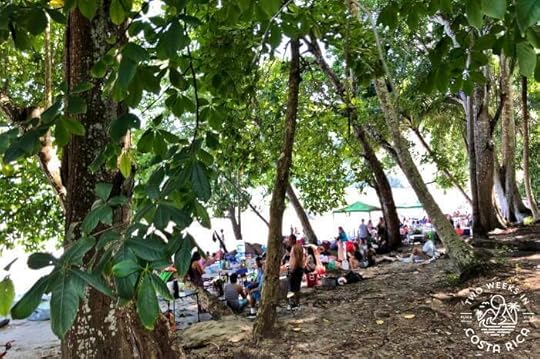 A busy beach on Sunday
A busy beach on SundayParking is 1,000 colones an hour (about $1.50). Payable in cash only.
When you come to the gate, you’ll take a ticket. Hold onto it, then you’ll present it to the attendant on your way out. There’s also a QR code they recommend you can scan in case you accidentally lose the ticket.
Parking hours are from 7:00 a.m. to 5:00 p.m.
From the parking lot, there’s a path to the beach. It is well maintained and leads to the southern end.
 The short path from the parking lot to the beachShowers
The short path from the parking lot to the beachShowersA benefit of the parking lot is that you can use the outdoor showers to rinse off after. There are about eight of them, near where the beach path starts. A bathroom is also located in the guardhouse.
 The rustic showers near the parking lotWalking
The rustic showers near the parking lotWalkingYou also can walk into Playa Mantas. Right before the parking lot on the right is an unmarked, but very visible, path (different from the other path from the parking lot). If you take this, you can walk right to the beach without paying anything.
It is about a five-minute walk from the road to the beach.
The walking path drops you off in the middle of the beach. If you head right (north), the path leads behind the trees along the fringes of the Punta Leona Resort. If you want to go to the southern end of Playa Mantas, you’ll just head left towards the water and walk on the sand.
 The Punta Leona Resort sits back from the beach. It’s on the other side of the path so not right on the sand.Wildlife
The Punta Leona Resort sits back from the beach. It’s on the other side of the path so not right on the sand.WildlifeOne of the cool things about Playa Mantas is that you can often see wildlife.
White-faced monkeys love to hang out in the middle area where there are a lot of people. These guys can be aggressive, so be sure to keep an eye on your bags. They will try to steal your food!
You also can see Scarlet Macaw parrots. These are big red birds with blue and yellow that are relatively common in the Jaco area, but still special. They feed in beach almond trees. You can often hear their loud squawk before you see them.
We’ve also seen iguanas, Jesus Christ Lizards in the stream along the walking path, and pelicans feeding in the sea.
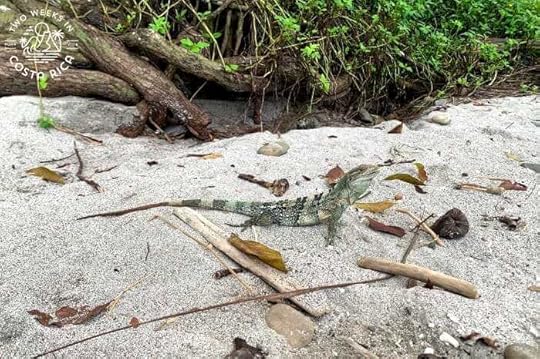 An iguana searching for fruits on the sandPlaya Blanca
An iguana searching for fruits on the sandPlaya BlancaAnother highlight of Playa Mantas is its proximity to Playa Blanca.
Just on the other side of the southern point is this gorgeous beach.
Playa Blanca has fluffy white sand. This may seem like a small detail, but most of the sand on the central Pacific coast is volcanic and fine. At Playa Blanca, the texture is thicker, making it feel nice and fluffy under your toes.
 Playa Blanca, just on the other side of the point
Playa Blanca, just on the other side of the pointYou can’t drive to Playa Blanca unless you’re a guest at the Punta Leona Resort. But you can access it by walking south along the sand from Playa Mantas. This is best done at low tide.
Read our post, Playa Blanca: A White-Sand Oasis Near Jaco, for more details.
Directions to Playa MantasTake the coastal highway 34 to Punta Leona. If you’re coming from Jaco, the road to Playa Mantas will be on the left, shortly before the main entrance to Punta Leona Resort. Look for the large restaurant, Los Guarumos, as you’re coming down the hill. The left is a few hundred meters after that.
This is called Calle Vieja, the old road to Playa Mantas.
There will be a tiny grocery store on the left after you turn and some condos. The road will be paved for a few minutes, then turn to dirt (usually with many bumps). This stretch is rainforest-covered and not very developed.
When you get closer to Punta Leona, it’ll turn to bumpy pavement again. You’ll pass some houses and condos, another mini-super grocery store, a pizza restaurant, and Pops ice-cream shop.
After driving for about ten minutes total, you’ll come to the parking lot on the right.
4×4 is not necessary for the drive but be careful as the road is narrow in some places.
ConclusionPlaya Mantas is definitely one of our favorite beaches along Costa Rica’s central Pacific coast. Although it can be busy on weekends, this is also a fun, festive time. From your beach chair, you can catch a glimpse of the local culture, all while enjoying the beautiful tropical scenery.
Have a question about visiting Playa Mantas? Ask us below.Looking for more information to plan your trip to Costa Rica? Check out these posts:Jaco: Costa Rica’s Booming Beach Town – Jaco has a fun vibe and great restaurants. Check out our post for activity, hotel, and food recommendations.
La Fortuna: What to Expect – La Fortuna/Arenal pairs well with a visit to the Jaco area. Our post has details on things to do like volcano hikes and zip lining as well as tips on where to stay.
Best Beaches for Families in Costa Rica: Interested in visiting more beaches with calm water? This post has six ideas.
The post Playa Mantas: Calm Water and a Local Vibe appeared first on Two Weeks in Costa Rica.
November 18, 2021
Renewing Permanent Residency in Costa Rica
Two Weeks in Costa Rica |
Those who have gone through the residency process in Costa Rica and received their DIMEX card (known locally as a cedula) know what a process it is. Once you hold that little piece of plastic in your hand, it is such a relief. Unfortunately, these cards are only valid for a certain amount of time and need to be renewed. In this post, we will go through the process of renewing permanent residency in Costa Rica. While this applies to those holding permanent residency, others who have temporary residency or other types may find some useful tips as well.

After navigating the lengthy residency process, you might be surprised to learn that your brand-new Costa Rica DIMEX card is only valid for a couple of years.
We applied for permanent residency through the birth of our first child and received DIMEX cards (cedulas) that were valid for two years. When we renewed those, we were given another two years.
Now, on our second renewal, we have been given cards that are valid for three years.
Fortunately, the process of renewing is a lot less complicated than your original residency application. You’ll only be asked to provide a few documents as well as your old card. We’ll get into the details below.
When to Renew?You can begin the process of renewing your DIMEX up to three months before it expires. However, if you are like most people (including us), you have waited until much closer to the expiration date.
Don’t wait too long, though. Without a valid DIMEX card, it can be difficult to do many things.
You won’t be able to open any new accounts (e.g., cell phone plans, contracts), and banks and other institutions likely will not let you present your cedula as a form of identification to make transfers or apply for services.
And don’t forget that without a valid card, you’ll have to pay those higher non-resident prices at places like national parks. They sure are strict about that!
If you have missed the deadline, you can still renew a permanent residency card up to three months after it expires. However, after three months, you need to have a lawyer write a letter giving a valid explanation of why you are more than three months’ overdue.
For temporary residents, if you are three months’ overdue, you need to renew through Migracion.
Where Can You Renew?There are a few options for people who need to renew their DIMEX cards.
You can either make an appointment at Correos de Costa Rica (the country’s post office) or Banco de Costa Rica (BCR, a bank).
Not all branches offer the service; however, there should be one within a reasonable drive from where you live.
Additionally, those who are over the age of 65 can go directly to Migracion in La Uruca, San Jose to renew and receive a new card the same day. According to a local law firm, this service is available only on Thursdays and Fridays and no appointment is needed.
[image error]BCR in JacoRenewing Your DIMEX/Permanent Residency at BCR BankWe chose to renew our cedulas at the BCR on both occasions. Mostly because the post offices near us are small and always very crowded and hectic. BCR seemed more organized and efficient.
Making an AppointmentCalling the HotlineTo make a DIMEX renewal appointment at BCR, you will need to call them at 800-BCRCITA (227-2482). This is a toll-free call that can be made using a post-paid or prepaid phone.
Most of the times we have called, the operator has only spoken Spanish. However, we did once have an English-speaking representative.
Before calling, we would recommend visiting the BCR website to get familiar with the process. Under the section Personas, you can find another section called Punto Pais. This is a list of all the personal services offered at the bank like paying your Marchamo, getting a passport, etc.
From here, click on Cita para Cédula de Residencia. On this residency appointment page, you’ll find a brief description of the process.
When you call, you’ll be asked for your name, email, DIMEX/cedula number, the date it expires, and what bank branch you would like to make an appointment at. The list of available BCR branches is here.
What You’ll Need to BringThe representative also will explain what you need to bring. The list has been the same both times we have renewed.
Original DIMEX card that is going to expireProof of most recent payment in the CCSS system (Caja) – see belowA signed letter declaring who you are and the full names of both of your parentsBefore you end your call with the BCR representative, you’ll be given date and time options for the appointment. We have usually gotten an appointment within a week.
You’ll also receive a confirmation number for the appointment. A confirmation should be emailed to you as well. This last time we renewed, one of us did not receive the email confirmation, but when we called back later to make sure everything was all set, they verified our appointment in the system.
Proof of CajaIMPORTANT: For proof of Caja payment, you’ll have to show up in the Validacion de Derechos system as active and covered. The BCR rep will check this during your appointment.
For those who are insured under their spouse, there is often a problem proving coverage. This is because you need to renew the dependent status at your local CCSS office every couple of years. Sometimes this association lapses between renewals and you will have to visit CCSS (sometimes more than once) to straighten it out. This is all another good reason to start renewing early!
If you are married and under your spouse’s account, you will probably need to show the CCSS an apostilled marriage certificate to prove you are still married. Some people have gotten married in Costa Rica to avoid the hassle of having to get a new apostilled marriage certificate every couple of years.
 CCSS website where you can check to make sure your Caja is current in the systemDIMEX Renewal Appointment
CCSS website where you can check to make sure your Caja is current in the systemDIMEX Renewal AppointmentOn the day of your renewal appointment, make sure to show up to the bank a little early. Also, let the security guard at the door know that you have an appointment before getting in line. Often, they have a separate line for people who are scheduled for services.
In the bank, there will be a separate office/line for the BCR representative who processes residency renewals.
When it is your turn, the BCR rep will collect your required documents, make some copies, and have you fill out a short form (address, date of birth, etc.). You’ll then need to pay the associated fees for the renewal and have your picture taken.
With all of this done, you’ll get a piece of paper called a Comprobante de Solicitud, Tramite de documento de extranjeros DIMEX (Proof of Application of Processing Foreigners’ DIMEX). This will have all your information, like your expediente number, cedula number, immigration category, and date of birth. It also will have the date that the new card will be available for pick up at the post office (usually a month after your appointment date).
If you are going around with an expired DIMEX card, it would be a good idea to keep a copy of this voucher with you until you get your new card. You can then show it to an official if needed and explain that you have renewed and are still waiting for the new card.
Cost of RenewalThe fees you need to pay include a renewal solicitation fee (Migration’s fee, around $125), shipping to have the new card delivered to your nearest Correos de Costa Rica (about $7), and the bank’s commission (around $8).
Overall, the total amount we paid was a little less than $150 each.
It’s important to know that you cannot pay by credit card. You must either take the money out of your BCR account or pay it in cash.
Picking Up Your New DIMEX CardThe BCR website says that it will deliver the card within 22 business days. However, we have heard of long delays of two months or more when waiting for the new DIMEX card to arrive.
Fortunately, this was not the case for us (in October 2021). We checked at the post office for our card exactly at the one-month point (22 business days) and it had arrived a few days before.
When picking up the card, you’ll need to show your application voucher (comprobante de solicitud) and old cedula.
This time, the postal worker also opened the package and showed us that the card was in good condition before having us sign for it.
There is no charge at the post office since you already paid for the shipping at the renewal appointment.

We do not have experience renewing at the post office in Costa Rica; however, it looks like many of the requirements and process are the same.
For those interested in pursuing this method, you can visit the Correo’s page for residency renewal.
The required documents for each residency category are listed on this sheet. It also gives the fees associated with renewal. You will have to deposit some of the fees into a specific BCR account before your appointment.
If you have experience with renewal at the postal offices in Costa Rica, feel free to leave a comment below to help others navigate the process.
ConclusionRenewing permanent residency in Costa Rica may seem like a daunting task, but if you start early and know the process, it should be fairly simple. Once you receive that new plastic card with your picture on it, you can breathe easy for a couple of more years before you have to worry about it again. We hope this post has helped you get prepared and best of luck with your renewal!
Have a question or want to share your DIMEX renewal experience? Leave a comment below. Looking for more information to help you navigate life in Costa Rica? Check out these articles:Starting a Business in Costa Rica as an Expat – Thinking of the next big business idea for Costa Rica? Check out this article for some insights into what’s involved and what to plan for.
Buying a House in Costa Rica – Ready to buy in Costa Rica? We went through this process ourselves and share our experience.
Having a Baby at Hospital CIMA – Our experience giving birth at one of San Jose’s best private hospitals.
The post Renewing Permanent Residency in Costa Rica appeared first on Two Weeks in Costa Rica.
November 12, 2021
Costa Rica’s Vaccine Passport
Two Weeks in Costa Rica |
Recently, Costa Rica announced that it will start requiring proof of Covid vaccination to enter certain businesses. In this post, we will explain the details of Costa Rica’s vaccine passport. We’ll cover the timing, which businesses apply, how tourists are affected, and what kind of proof will be needed.

In October 2021, the Costa Rica government announced that it would start requiring full Covid vaccination to enter non-essential businesses. Originally, the mandate was to start on December 1, 2021. However, after getting pushback from the tourism sector, the government agreed to make the requirement more gradual.
Now there is a transition period.
Transition Period: December 1-January 7Specifically, from December 1-January 7 (peak travel season in Costa Rica), a business on the list can choose to operate at 100% capacity and require full vaccination to enter. Or they can operate at 50% capacity and not require vaccination. Businesses included are hotels, restaurants, and stores (see full list below).
This means that for the businesses that decide to operate at full capacity, you will have to show proof of vaccination to enter starting in December.
 Sign to be displayed at a business that requires full vaccination starting on Dec. 1. It can operate at 100% capacity.
Sign to be displayed at a business that requires full vaccination starting on Dec. 1. It can operate at 100% capacity.So far, we have heard of some hotels adopting the 100% capacity mode. This means you will have to be fully vaccinated to enter. We think many restaurants and stores will likely choose not to require proof of vaccination and just have limited 50% capacity during the transition period.
 Sign to be displayed at a business that is NOT requiring full vaccination from Dec. 1-Jan. 7. It can operate at 50% capacity and will have to require full vaccination starting on Jan. 8.
Sign to be displayed at a business that is NOT requiring full vaccination from Dec. 1-Jan. 7. It can operate at 50% capacity and will have to require full vaccination starting on Jan. 8.If you are not vaccinated and traveling during this transition period (December 1-January 7), contact your hotels to find out their policy.
IMPORTANT: The vaccine mandate only applies to people ages 12 and up.* Children under 12 are currently exempt. There is also a medical exemption (see below).
*The government recently announced that children ages 12-17 will not have to show proof of vaccination until January 31, 2022.
January 8 and BeyondStarting on January 8, 2022, the vaccine passport will take full effect.
All businesses on the list will have to require proof of Covid vaccination to enter. This applies to Costa Ricans and foreigners/tourists visiting Costa Rica.
Businesses on the ListBasically, the vaccine mandate applies to non-essential businesses. Adventure tourism is also included. Here is the full list:
Restaurants, cafeterias, food courts, and food trucksBars and casinosGeneral stores, department stores, and shopping mallsMuseumsFitness centersHotels, cabins, or lodging establishments**Most people are including Airbnbs and vacation rentals in this category; however, we have not seen anything official from the government.
SpasActivities, organizations, or congregations in places of worship with more than 750 peopleEvent rooms for business, academic, or social activitiesAdventure tourism (see detailed list in section below)Theaters, cinemas, art and dance academies, and establishments for artistic activitiesSports facilities

Essential services like grocery stores, pharmacies, and hospitals are exempt from the vaccination requirement. But they must remain at 50% capacity. However, these businesses can choose to require proof of vaccination and operate at 100% capacity.
Showing Proof of VaccinationBusinesses will verify vaccination status using QR codes.
Costa Rican citizens and residents will request a QR code from the government.
Tourists visiting the country will get a QR code as part of the Health Pass.
 This is similar to what your QR code will look like
This is similar to what your QR code will look likeThe Health Pass is the online form that you already have to fill out to enter the country. Here, you will upload your vaccination card or certificate and get a specific QR code to show to enter businesses. The Costa Rican government has said that this will be ready starting on November 22.
Tourists will not be able to show their foreign vaccination card. As of now, only a QR code will be accepted.
All documents submitted to the Health Pass must be in English or Spanish.
What Does Fully Vaccinated Mean in Costa Rica?OverviewFully vaccinated in Costa Rica means that you (1) have been vaccinated using an approved vaccine, and (2) you have received the total number of doses recommended by the pharmaceutical company.
The final dose has to have been applied at least 14 days before entry.
Here is the list of approved vaccines:
AstraZeneca: 2-dose seriesPfizer-BioNTech: 2-dose seriesModerna: 2-dose seriesJohnson & Johnson: single doseSinovac-CoronaVac: 2-dose seriesSinopharm: 2-dose seriesCovaxin: 2-dose series List of approved vaccines in Costa Rica. Photo credit: Instituto Costariccense de TurismoMixed Vaccines
List of approved vaccines in Costa Rica. Photo credit: Instituto Costariccense de TurismoMixed VaccinesIf you have been vaccinated using two different vaccine brands (e.g., AstraZeneca for first dose and Moderna for second dose), this will be considered a complete vaccination as long as the vaccines are both approved. This is from the Costa Rica Tourism Board’s FAQs sheet and also detailed in the instructions for the Health Pass.
Medical ExemptionThe Tourism Board has said that the vaccination requirement does not apply to tourists with a duly accredited medical condition that makes it not possible to receive an approved vaccine. They must attach their medical report (in English or Spanish) to the online Health Pass.
Presumably, after the Tourism Board has reviewed their Health Pass and confirmed they are exempt for medical reasons, they will be able to receive a QR code to enter businesses.
Unvaccinated TouristsRegarding unvaccinated tourists, the Costa Rica Tourism Board has said tourists who are not fully vaccinated will be able to enter the country and “stay with family, friends, or in their own homes.” However, they will not be able to enter businesses that require full vaccination.
They will need to purchase Covid travel insurance to enter. For more information, see our post, Costa Rica’s Required Travel Insurance: 15 FAQs.
Using a Negative Covid Test Instead of Proof of VaccinationThe government has said that only proof of vaccination via a QR code will be acceptable. You will not be able to show proof of a recent negative Covid test to enter businesses.
Fully Recovered TravelersThe Tourism Board addressed this in their FAQs document; however, the information is not that clear.
Basically, it says that tourists who have recovered from Covid may meet the requirements. They say that each country has its own mechanism to verify vaccination status, and that tourists must present evidence via the Health Pass.
This includes recovered travelers whose health authority has applied a single dose of a Covid vaccine. See Q. 22 of the FAQs document for more information.
Which Adventure Tourist Activities are Included?Here is the list of adventure tourism activities that will have to require proof of vaccination starting on January 8 (some may require it starting on Dec. 1):
Terrestrial activities such as hiking, mountain biking, trekking, and horseback riding.In-air activities such as ballooning (hot air balloons) and paragliding.Aquatic activities such as rafting, scuba diving, tubing, kayaking, and parasailing.Activities with cables and ropes such as climbing, bungee jumping, rappelling, zip-lining, canyoning, via ferrata, spelunking (caving), high ropes, and pendulum (Tarzan swing).Motorized activities such as ATV, motorcycles, boats, and jet-skis.
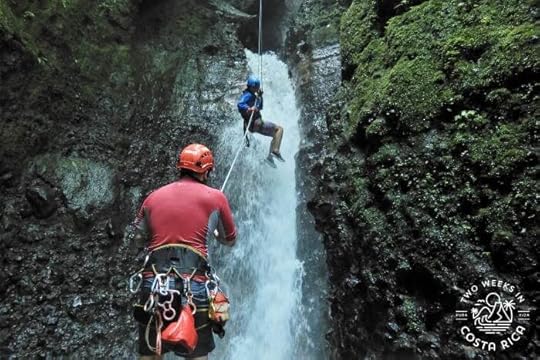
This issue has been evolving since it was first announced in October. Now that the Tourism Board has included this information on their website, it does seem that it is happening. However, after living here for many years, we have learned that things can change quickly. We will continue to follow this issue and update this article as needed. For the most current information, feel free to follow us on Facebook. We often provide quick updates on there.
Have a question about Costa Rica’s new vaccine passport/vaccination requirements? Ask us below.Looking for more information to plan your trip? Check out these posts:Traveling to Costa Rica During Covid-19: Entry Requirements, Protocols & What to Expect – Learn more about the online Health Pass and what to expect regarding masks and protocols at hotels and other businesses.
Covid Vaccination Rates in Costa Rica: See how Costa Rica is doing with its vaccination campaign.
Where to Get a Covid-19 Test: The United States and many other countries are still requiring a negative Covid test to get back home. Check out our list of where to get tested.
The post Costa Rica’s Vaccine Passport appeared first on Two Weeks in Costa Rica.
November 5, 2021
Patacones (Fried Plantains) Recipe
Two Weeks in Costa Rica |
Patacones are a staple in Costa Rican cuisine. These fried green plantains are relatively simple to make and delicious. Making them always feels like a treat in our house. We often top ours with refried beans, guacamole, or salsa to make them even more decadent. In this post, we’ll share an easy recipe for making homemade patacones.
[image error]
BackgroundGreen vs. Yellow PlantainsPlantains are those large banana-like fruits that grow in tropical places like Costa Rica. They come from a similar-looking tree to the banana.
 Plantain and banana trees in our backyard
Plantain and banana trees in our backyardWhen the fruit is first picked, it is a dark green color. As it ripens, it turns lighter green, then eventually yellow.
Green plantains are the ones you want for making patacones. They have a higher starch content and nice savory flavor. When the fruit is green, it’s hard.
Yellow plantains are much softer and very sweet. They are used to make maduros. These are the little pieces of plantain you see served at breakfast in Costa Rica with gallo pinto and lunch with casados.
 Unripe green plantains (for patacones) and ripe yellow plantains (for maduros)How Are Patacones Served in Costa Rica?
Unripe green plantains (for patacones) and ripe yellow plantains (for maduros)How Are Patacones Served in Costa Rica?In Costa Rica, you can find patacones on the bocas (snacks) menu of many restaurants. Often, they come with refried beans and guacamole. You can make them into a meal this way.
Patacones are also sometimes served with ceviche (fresh raw fish marinated in lemon juice).
Patacones RecipeServes approximately 4 people.
Ingredients3 green plantains
Oil for frying (we use canola)
Salt

Traditionally for patacones, the plantains are fried twice in oil. First, they are chopped into chunks and then cooked for a few minutes on each side. Then after, they are flattened and cooked again in oil.
We learned a trick that only requires frying once, which we really like.
Soften the PlantainsFor this method, you will microwave the plantains first to soften them.
Take your whole green plantains with the skin still on and wrap them in wet paper towels. Microwave them on high for about 5-6 minutes.
Let cool for about 5 minutes more so that they are easier to handle.
Once cool, cut a slit the long way in each plantain and remove the skin.
Cut and Smash the PlantainsOnce you have the skin off, remove the ends of the plantain. Then cut into about 3/4 inch pieces.
[image error]Cut the plantain into approx. 3/4 inch chunksNow you’ll need to flatten them a bit so they are a good thickness for frying.
Take each piece and press it down with something heavy. We have used a small cutting board before, but the back of a plate or pot would work too. If you have a tortilla press, even better. If they are sticking, nudge them off with a knife or use wax paper.
When you’re done, each piece should be about ¼-½ inch thick.
 A flattened plantain, ready for frying
A flattened plantain, ready for fryingTip: Depending on how ripe your plantains are and how strong your microwave is, you may need to microwave them for more than 5 minutes. If the plantains are still really hard and difficult to smash, put them back in the microwave for a couple of minutes (wrapped in a wet paper towel). You want them to be firm but not squishy.
Fry the PlantainsIn a large frying pan or cast-iron skillet, add enough oil to coat the bottom of the pan about 1/4 inch.
Turn heat onto medium.
Once the oil is hot, add the plantain pieces. Cook for about 3 minutes on each side until nicely browned.
 Fry the plantains on each side until golden brown
Fry the plantains on each side until golden brownRemove from oil, place on paper towels, and season with a good pinch of salt right away. The salt really brings out the flavor of the plantain.
 The final product. Be sure to season with salt!Serve
The final product. Be sure to season with salt!ServePatacones are salty and crunchy and delicious on their own. But if you want to make a meal out of it, we recommend serving them with guacamole, refried beans, and fresh salsa. A little hot sauce can be yummy too!
ConclusionMaking plantains can be overwhelming when you first try it, but we have never had a bad batch! Our kids love them, and they are a surefire way to bring a taste of Costa Rica into your home.
Have a question about making patacones? Ask us below.Some of the links in this post are connected to affiliate programs we have joined. As an Amazon Associate we earn from qualifying purchases.
Looking for more Costa Rica-inspired recipes? Check out these posts:Making Costa Rica’s Famous Arroz con Pollo: Our recipe for delicious and authentic arroz con pollo (rice with chicken).
Making Homemade Costa Rican-Style Beans: Rice and beans is an essential in our house. Check out our recipe for cooking dried red or black beans.
FAQs About Moving to Costa Rica: Thinking about making the big move? This post answers common questions about residency, working, and more.
The post Patacones (Fried Plantains) Recipe appeared first on Two Weeks in Costa Rica.
October 22, 2021
Hanging Bridges in Costa Rica: Where to Go for the Best Experience
Two Weeks in Costa Rica |
A great way to explore Costa Rica’s many diverse ecosystems is by walking along hanging bridges through the treetop canopy. The amazing view paired with the adventure of crossing a swaying suspension bridge is on many bucket lists. There are a couple of key places where you can find hanging bridges in Costa Rica. There also are a scattering of more hidden spots. In this post, we’ll share some fun hanging bridge hikes around the country.
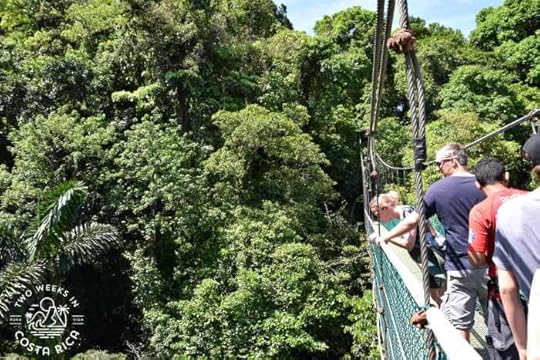
In Costa Rica, there are two main spots where you can experience elaborate hanging bridges.
These are the tourist towns of La Fortuna and Monteverde. Both are located in the middle/northern part of the country. They are about equidistant (2.5 hours) from the international airports in Liberia and San Jose.
La Fortuna/ArenalLa Fortuna is a well-known destination that is famous for the cone-shaped volcano named Arenal. Although the volcano doesn’t erupt anymore, it’s an impressive site to see.
In La Fortuna, you’ll find two larger hanging bridge facilities. One is Mistico Hanging Bridges Park. The other is Sky Adventures (Arenal Park).
Mistico Hanging Bridges ParkMistico is the easier of the two major options in La Fortuna.
The hike at Mistico is a two-mile (3.2 km) loop along concrete paths. They also have a one-mile (1.5 km) trail that is handicap accessible.
The main trail winds through the hillside jungle over six long suspension bridges. On one of the hanging bridges, you have a great view (weather permitting) of Arenal Volcano.
[image error]Hanging bridge at Mistico near La Fortuna/ArenalThe downside of Mistico is that it can feel a little like a theme park during peak tourist months (generally mid-December to early-April). During these times, buses and tour vans full of people arriving from La Fortuna and other parts of the country can sometimes crowd the trails.
Overall, though, Mistico is a great choice for a hanging bridge experience.
For much more information, read our post, Mistico Hanging Bridges: A Treetop Rainforest Experience.
Sky Adventures Hanging Bridges (Arenal Park) Overview of Sky AdventuresAnother larger facility with hanging bridges in La Fortuna is Sky Adventures.
This company is located near the town of El Castillo (30 minutes from downtown La Fortuna). They also have a location in Monteverde, which we will cover in the section below.
The Sky Adventures facility has other tours as well. These include zip lining, rappelling, and a gondola/tram ride. This makes it a good option for people who want to pack more activities into their day.
Sky Adventures Hanging Bridge HikeEven if you don’t want to do other activities, it is worth a visit to Sky Adventures solely for their hanging bridge hike. This activity is called the Sky Walk.
The trail is 2.5 miles (4 km) and crosses five large suspension bridges. Each one is spaced out through the jungle.
Along the way, you can see impressive tropical plants and trees, wildlife like snakes and birds, and also a waterfall.
Be sure to get some pictures of Lake Arenal from the Mirador. There’s also an amazing volcano view from the Reception area.
[image error]View of Lake Arenal from Sky AdventuresThis hike feels a little wilder in comparison to Mistico. A lot of the time is spent walking through a big section of primary rainforest (pristine forest that has never been cut down).
The trails are dirt or gravel. And it’s less crowded because admission time slots are spaced out.
MonteverdeLocated high in the mountains along the Continental Divide, Monteverde is another great destination to experience hanging bridges. In Monteverde, the cool climate and constant wind and mist create a unique cloud forest habitat.
On hanging bridges, you can walk through the mossy canopy and experience some fantastic views. Sometimes the fog even covers part of the bridges, giving you the feeling of walking through the clouds.
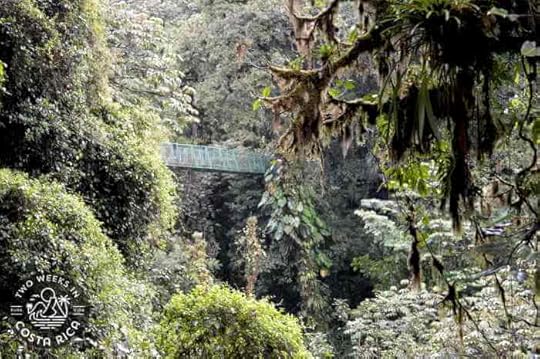 Hanging bridge in Monteverde, deep in the cloud forest
Hanging bridge in Monteverde, deep in the cloud forestLike La Fortuna, Monteverde has two major facilities where you can experience hanging bridges. They are Selvatura Park and Sky Adventures (Monteverde Park).
Selvatura Park Hanging BridgesOur pick in Monteverde for hanging bridges is Selvatura Park.
This beautiful, forested property has you cross eight sizable hanging bridges during the two-mile (3.2 km) walk. The bridges range from 170 feet (52 meters) to 560 feet (171 meters).
[image error]A hanging bridge at Selvatura ParkThe trail between the bridges is flat, easy, and well maintained.
Along the way, keep an eye and ear out for some of the bird species native to the cloud forest. These might include the Three-wattled Bell Bird, Emerald Toucanet, and Golden-browed Chlorophonia.
 A beautiful Golden-browed Chlorophonia that we saw from one of the bridges
A beautiful Golden-browed Chlorophonia that we saw from one of the bridgesTip: Although you can visit the hanging bridges on your own, guides (available through most facilities) are a great way to ensure you will see some local wildlife. In the cloud forest, it can be especially difficult to spot things because of the thick forest and wet conditions.
Sky Adventures Hanging Bridges (Monteverde Park)A short distance up the road from Selvatura is Sky Adventures. Like the one they have in La Fortuna, there are other activities available, like zip lining and a tram/gondola ride.
Sky Adventures’ Monteverde Sky Walk has a 1.5 mile (2.4 km) trail that winds along a hillside over six suspension bridges.
In comparison to Selvatura, Sky is a shorter hike but more difficult. The trails are not as flat and more rustic. Most of the trail is dirt, but well maintained.
One cool feature is that one of Sky Adventures’ suspension bridges is an impressive 774 feet (236 meters) long!
At both Sky Arenal and Sky Monteverde, you can do the hike guided or self-guided. It doesn’t cost much more to add a guide and worth it in our opinion.
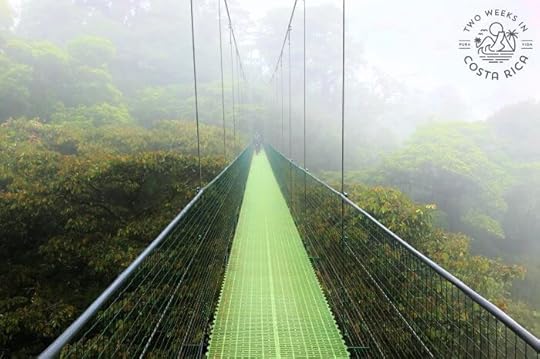 Clouds rolling across this hanging bridge at Sky Adventures in MonteverdeOther Locations in Costa Rica with Hanging Bridges
Clouds rolling across this hanging bridge at Sky Adventures in MonteverdeOther Locations in Costa Rica with Hanging BridgesWhile La Fortuna and Monteverde have the most elaborate hanging bridges, you can still find others around the country. This list of more hanging bridges in Costa Rica doesn’t include all of them but will give you some fun options.
Manuel AntonioOn Costa Rica’s central Pacific coast, Manuel Antonio is best known for its popular national park, abundant wildlife, and beautiful beaches.
If you are looking for hanging bridges here, you’ll have to get a bit off the tourist trail. About 30-minutes away is a private reserve called Rainmaker.
Rainmaker is a large property with some nice hiking trails through the primary rainforest. It is much quieter than the busy national park.
On the upper trail at Rainmaker, you can cross a series of rustic hanging bridges. These wobbly, narrow bridges connect wooden platforms built around giant old-growth trees.
Remember to bring your swimsuit for a dip in the cool river after hiking.
For more information about Rainmaker, read our post all about it.
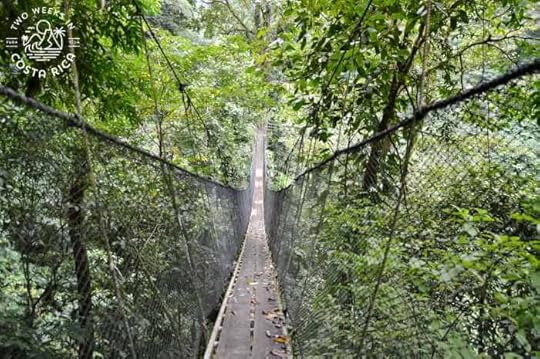 One of the rustic hanging bridges at Rainmaker near Quepos/Manuel AntonioMontezuma
One of the rustic hanging bridges at Rainmaker near Quepos/Manuel AntonioMontezumaLocated on the southern Nicoya Peninsula, Montezuma is a cool beach town with a bohemian feel.
A main attraction in town is the Montezuma Waterfalls. This series of cascades has two access points, one of which takes you on some hanging bridges.
Hikers either can take the lower trail, which weaves along the riverbank, or the upper trail through a private canopy-tour property.
On the upper trail, you’ll pay admission through Sun Trails and walk some long hanging bridges to the top of the Montezuma Waterfalls. Here, you’ll find swimming holes and smaller waterfalls, which feed into the bigger fall at the end.
To learn more, check out our post, Montezuma Waterfalls: Best Ways to Access.
 You can access the Montezuma Waterfalls using a trail and hanging bridgesBijagua
You can access the Montezuma Waterfalls using a trail and hanging bridgesBijaguaThe small town of Bijagua, about an hour north of La Fortuna, is best known for the bright blue Rio Celeste Waterfall. But this rainforest-covered area is also a hotspot for birds and other wildlife.
A good way to see some cool jungle creatures is, of course, on some hanging bridges.
Heliconias Rainforest Lodge, right in Bijagua, has three long suspension bridges on their 175 acre (73 hectare) property. The jungle trail connecting them will take you through some impressive swaths of rainforest.
 A white-faced monkey we saw on the hike at Heliconias Rainforest LodgeMiravalles
A white-faced monkey we saw on the hike at Heliconias Rainforest LodgeMiravallesFor a daytrip from Guanacaste or a stop between destinations, the Miravalles Volcano region is a nice off-the-beaten path alternative to busier places like Rincon de la Vieja.
In the small town of La Fortuna de Bagaces, you can find some simple hot springs (one nicer resort) and a property called Las Hornillas.
Las Hornillas is a very unique spot. Here, there is volcanic activity in the form of steam and mud literally bubbling from beneath the surface. You can explore the volcanic features, take mud baths, soak in hot springs, and enjoy a short hike with a few hanging bridges.
On one of the bridges, you can see all the way to the Gulf of Nicoya on a clear day!
To learn more about this area, see our post, the Untapped Miravalles Volcano: Hot Springs, Nature, and Zero Crowds.
[image error]Sweeping valley view from one of the hanging bridges at Las HornillasPuerto Viejo de SarapiquiBetween La Fortuna and Caribbean coast destinations is the small town of Puerto Viejo de Sarapiqui. In Sarapiqui is a lodge and nature reserve called Tirimbina.
On a hike of the reserve, you’ll need to cross the wide Sarapiqui River. To do this, you cross a really impressive hanging bridge.
Make sure to stop halfway to enjoy the river view and maybe wave to some rafters passing below.
Our post, Tirimbina: An Eco-treat in Sarapiqui has much more information on what to expect.
 The long hanging bridge over the Sarapiqui River at Tirimbina Lodge and ReserveConclusion
The long hanging bridge over the Sarapiqui River at Tirimbina Lodge and ReserveConclusionPeople who visit Costa Rica often tell us that the combination of nature and adventure they experienced are what makes them want to come back again. Hanging bridges provide both and are why we think this experience is one that you won’t want to miss on your next trip.
Have a question about hanging bridges in Costa Rica? Leave a comment below. Looking for more information to help you plan the perfect Costa Rica trip? Check out these posts:Planning a Family Vacation to Costa Rica: Essential Tips and Info – Coming with the kids? Grandkids? Check out this post for family-friendly destinations and tips on how to keep a balance so everyone has a great time.
Driving in Costa Rica: What to Know Before You Go – What to expect driving in Costa Rica, from general road conditions to driving at night and more.
Costa Rica Destinations Guide – A list of Costa Rica’s major and smaller destinations. Each one includes a short summary and description. Links to full articles will help you narrow down your itinerary quickly.
The post Hanging Bridges in Costa Rica: Where to Go for the Best Experience appeared first on Two Weeks in Costa Rica.
October 14, 2021
Things to Do in La Fortuna with Young Kids
Two Weeks in Costa Rica |
We have several articles on this site about traveling to Costa Rica with kids. In this post, we’re going to get super specific and focus on traveling with young kids to La Fortuna (babies, toddlers, and preschoolers). As parents, we know it can be hard to figure out which activities will be best for your family. And what’s good with 0-5 year olds can be a lot different than with older children. In this post, we’ll share some awesome things to do with young kids in La Fortuna/Arenal. We pull from our own experience, traveling with our two young boys.
[image error]
Best Things to Do in La Fortuna with Young KidsHere are our top picks for things to do in La Fortuna/Arenal with young kids.
Hikes and Nature WalksThe Arenal/La Fortuna area is brimming with thick jungle. But you don’t have to go far to experience the area’s amazing nature and wildlife.
 A green and black poison dart frog
A green and black poison dart frogLa Fortuna has a few different places to hike with babies, toddlers, and preschoolers.
Ecocentro DanausEcocentro Danaus is a great option. This is a small reserve right outside the downtown. It has one main loop that is only about a half-mile long and flat. This makes it perfect with little kids.
We have visited with our two-year old, and he walked almost the whole trail by himself!
The pebbled trail takes you through lush rainforest, with lots of nice shade so it doesn’t get too hot.
From the well-maintained path, you can see some of the area’s wildlife, like sloths, frogs, lizards, and birds.
There are also some stops along the way that are fun with kids. A butterfly enclosure will let them frolic among blue morphos and other beauties. At a frog pond, you can search for blue jean poison dart frogs or red-eyed tree frogs. And if you need a rest, you can take a break at the big green lagoon, while searching for caiman (small crocodiles).
 Butterfly garden at Ecocentro Danaus
Butterfly garden at Ecocentro DanausEcocentro Danaus can be done with a sturdy stroller with larger wheels.
Here is a link to our post, Ecocentro Danaus: Easy Wildlife Viewing Near La Fortuna, for more information.
Bogarin TrailFor a longer hike but still doable with little kids, there’s the Bogarin Trail. This reserve is also right near downtown La Fortuna.
The Bogarin Trail is known for its many sloths that live on the property. You also can see a lot of birds. Even our kids were excited at some of the species we spotted on our last visit. We saw a group of Gray-headed Chachalacas (a large pheasant-like bird) flying awkwardly across the trail, Laughing Falcons (which our five-year old declared was a hawk), and even a Black and White Owl sleeping in a tree.
The trail is 2.5 km (1.5 miles) long. It is dirt, but hard packed and very easy to walk on. It would be fine with a stroller.
 The nice, flat trail at the Bogarin Trail reserve
The nice, flat trail at the Bogarin Trail reserveThe Bogarin Trail has a pond near the entrance/office with a lot of tropical plants. These plants attract birds and other wildlife. Our kids loved spotting a huge crab in the little stream.
For more information about the Bogarin Trail, check out our post, Sloths, Birds, and More: The Bogarin Trail in La Fortuna.
Arenal Volcano National ParkIf you want to see the volcano close-up, one of the best options with young kids is Arenal Volcano National Park.
Arenal Volcano National Park has two sectors. The main trail gets you a nice volcano view. The trail is mostly flat, but 2.5 miles (4 km), so you’d probably want a baby carrier for little kids.
For an easier hike, there’s the Peninsula sector of the national park. This newer sector has a nice, paved trail. It goes through dense jungle and leads to an awesome view of Lake Arenal and Arenal Volcano. About mid-way through the walk, there’s a viewing platform that you can climb up.
 The viewing tower at the Peninsula sector of Arenal Volcano National Park
The viewing tower at the Peninsula sector of Arenal Volcano National ParkFor more information on visiting, check out our post, Hiking in Arenal Volcano National Park.
Hiring a GuideFor nature hikes, it’s a good idea to hire a guide so that you see the most wildlife. Sloths, monkeys, and other animals are often hiding high up in the trees. And it can be hard to spot things like frogs unless you know what you’re looking for. Some places, like Ecocentro Danuas, will have a guide for only your family. This is nice because they can cater the tour to you and your kids.
Chocolate/Coffee Tours for Young KidsA fun tour with young kids is a chocolate or coffee tour.
These are usually really interactive, with a lot of moving around to keep the kids busy.
La Fortuna has several coffee and chocolate tours.
One good one with kids is Rainforest Chocolate, which focuses solely on chocolate. The guides here are really fun and get the kids and adults involved in the whole process. There are even some funny jokes mixed in to lighten it up. There’s not too much walking around on this one too, making it great for little kids.
Another option our family has enjoyed is North Fields Café. They take you through their coffee fields and do both coffee and chocolate-making demonstrations. We were so surprised, but our boys enjoyed not only the chocolate part, but also the coffee segment. They loved picking the red coffee cherries from the plants and plucking out the white bean inside.
[image error]Looking for red coffee cherriesFor more information about the North Fields tour, read our separate post.
La Fortuna WaterfallLittle kids usually love water, and what better way to play than at a waterfall in the jungle!
La Fortuna Waterfall is a five-minute drive from the center of town. It’s very easy to access. There’s a nice visitor’s center where you buy your tickets, and they even have a restaurant.
From the visitor’s center, you have to walk down about 500 steps. But they are well maintained, concrete. You’ll also find benches to rest.
Once at the bottom, you can enjoy the gorgeous waterfall. The powerful cascade plunges 230 feet (70 meters) into a turquoise pool. All surrounding you is thick tropical greenery, made lush by the constant spray of mist.
 The amazing La Fortuna Waterfall
The amazing La Fortuna WaterfallAlthough the water in the main pool is often too strong for swimming, there’s a tranquil river just next to it.
Bring water shoes for the kids to help with the rocks. A baby carrier is handy for getting the little ones back up the stairs after.
Hanging Bridges for Young KidsHanging bridges provide built-in fun. These long suspension bridges wobble a little as you walk, bringing out the Indiana Jones in everyone. Although they sound scary, there is a great, safe option in La Fortuna.
Mistico Hanging Bridges has 16 bridges (suspension and regular fixed bridges) that take you through the rainforest canopy. Connecting the bridges is a sturdy concrete path. This makes it a fairly easy walk for little kids. Our five-year old has done this 2-mile (3.2 km) hike without a problem. Younger kids will probably need to be in a baby carrier most of the time, or you could bring a stroller. Mistico even has strollers available for rental.
 Family-friendly hanging bridges at Mistico
Family-friendly hanging bridges at MisticoThe bridges themselves are completely closed in and secure, but we still held our two-year old while crossing.
To learn more, check out our post, Mistico Hanging Bridges: A Treetop Rainforest Experience.
Boat Tours to See WildlifeA boat tour can be a fun and easy way to see wildlife. It’s a great activity for babies, toddlers, and preschoolers alike.
Cano Negro Wildlife RefugeOne option in the area is a pontoon boat ride at Cano Negro. This is a wetland system north of La Fortuna, near the Nicaragua border. It has tons of wildlife, including monkeys, crocodiles, and many types of birds.
This tour has no minimum age. The boat is sturdy and covered, and the ride is smooth along calm water.
Cano Negro is about one hour from La Fortuna.
Penas Blancas RiverFor something closer, there’s a safari float on the Penas Blancas River. At only about a half hour from the downtown, it cuts the drive time way down.
The Penas Blancas River has mellow water that is perfect for taking in the view and spotting wildlife. We’ve done this tour with our five-year old, and he loved it. We saw monkeys (white-faced and howlers), sloths, birds, small crocodiles, bats, and Jesus Christ Lizards.
After the rafting, there’s a fun interactive part of the tour. You stop at a house next to the riverbank and do a sugar cane demonstration. This is fun for kids because they can have a chance to grind the sugar cane rod into a sweet juice.
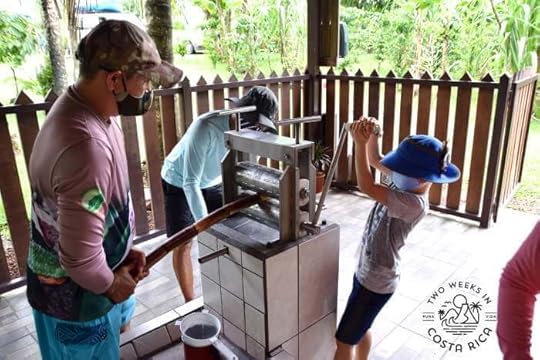 Grinding sugar cane into juice on a river float tour
Grinding sugar cane into juice on a river float tourThe tour is in an inflatable raft. The guide does most of the paddling. This activity is better for kids ages three and up.
For more information on the experience, read our post, A Safari River Float in La Fortuna/Arenal.
ConclusionLa Fortuna/Arenal is a wonderful place to bring young kids. It will leave them full of wonder about the cool animals and crazy bugs they saw in the jungle. Even if they don’t realize it, they’ll have a new appreciation for nature.

We hope this list of things to do with young kids in La Fortuna has helped narrow your family’s plans.
Have a question about visiting La Fortuna with your young kids or have something to recommend? Let us know below.Looking for more information to plan your family’s visit to Costa Rica? Check out these posts:La Fortuna Hotel Guide: Our picks for where to stay for volcano views, pools, and hot springs.
Vacation Rentals in Costa Rica: Safety Tips and What to Look for – Airbnbs are often a great option for families. This article has tips on what amenities are usually included, staying safe, and precautions to take.
Traveling with a Baby in Costa Rica: Our tips after traveling around with two kids. Covers availability of tubs, cribs, and highchairs, and how easy it is to find things.
Family Itinerary for Costa Rica: Rainforest, Beach, and Volcano – Wondering what beach to hit up after La Fortuna? This itinerary has some recommendations.
The post Things to Do in La Fortuna with Young Kids appeared first on Two Weeks in Costa Rica.



